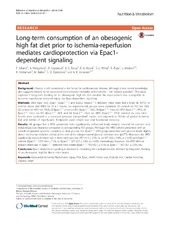| dc.description.abstract | Background: Obesity is still considered a risk factor for cardiovascular disease, although more recent knowledge also suggests obesity to be associated with reduced morbidity and mortality - the “obesity paradox”. This study explores if long-term feeding of an obesogenic high fat diet renders the myocardium less susceptible to ischemic-reperfusion induced injury via Epac-dependent signaling. Methods: Wild type (wt), Epac1 (Epac1−/− ) and Epac2 (Epac2−/− ) deficient mice were fed a high fat (HFD) or normal chow diet (ND) for 33 ± 1 weeks. Six experimental groups were included: (1) control wt ND (wt ND), (2) control wt HFD (wt HFD), (3) Epac1−/− mice on ND (Epac1−/− ND), (4) Epac1−/− mice on HFD (Epac1−/− HFD), (5) Epac2−/− mice on ND (Epac2−/− ND), and (6) Epac2−/− mice on HFD (Epac2−/− HFD). Isolated ex vivo mice hearts were perfused in a constant pressure Langendorff mode, and exposed to 30min of global ischemia (GI) and 60min of reperfusion. Endpoints were infarct size and functional recovery. Results: All groups fed a HFD presented with significantly enhanced body weight, visceral fat content and reduced glucose clearance compared to corresponding ND groups. Although the HFD cohorts presented with an overall comparable systemic capability to clear glucose, the Epac1−/− HFD group presented with glucose levels slightly above the human diabetes criteria at the end of the intraperitoneal glucose tolerance test (ipGTT). Moreover, the HFD significantly reduced infarct size in both wild type (wt HFD 41.3 ± 5.5% vs. wt ND 58.0 ± 9.8%, p < 0.05) and Epac2−/− cohorts (Epac2−/− HFD 34.4 ± 7.2% vs. Epac2−/− ND 56.5 ± 3.8%, p < 0.05). Interestingly, however, the HFD did not reduce infarct size in Epac1−/− deficient mice hearts (Epac1−/− HFD 65.1 ± 5.1% vs. Epac1−/− ND 56.1 ± 3.5%, ns.). Conclusion: Epac1-dependent signaling is involved in mediating the cardioprotection afforded by long-term feeding of an obesogenic high fat diet in mice hearts. | en_US |

